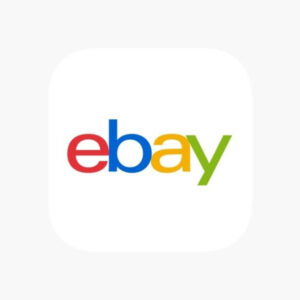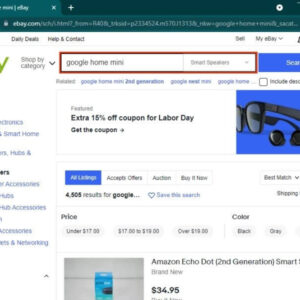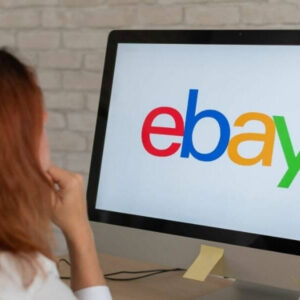What percentage does eBay take? As one of the OGs of eCommerce, eBay has evolved from a quirky online auction site into a top destination for online shoppers. Today, 88% of items on eBay are now sold as “Buy It Now,” fixed-price listings—and 80% of them are sold in new condition.
eBay ranks as the second most-visited marketplace website in the U.S., topped only by Amazon, according to Similarweb. And you can find both emerging and well-established brands selling their wares on the channel as part of their wider electronic and online business strategies.
This may lead you to wonder, is eBay worth adding to your multichannel selling strategy? It might be. But before jumping in, you’ll want to familiarize yourself with all the costs associated with selling on the marketplace. Let’s break down how much it really costs to sell on eBay.
What percentage does eBay take?
The amount eBay makes on a sale depends on the final selling price of the item, the category of the item, and any additional fees that may apply. On average, eBay takes between 10% and 15.55% of the final selling price in fees. This percentage can increase if you’re selling internationally or using promoted listings. It’s important to factor in all of these fees when pricing your items to ensure that you’re making a profit after all fees are taken into account.

What are Insertion Fees?
An insertion fee is a cost you need to pay to have your item listed. It costs 0.35 cents per listing. These costs are non-refundable regardless of whether your item sells.
If your product is in multiple categories, you will need to pay a new fee per category. If your listing has various items (and one type), you only receive one charge. If you create duplicate listings, you will need to pay for each one.
eBay will not charge you an insertion fee if you list fewer than 250 items per month. If you have an eBay Store, this allotment is larger. Both businesses and individuals are required to pay insertion fees after they exceed their monthly allowance.
Customer Service Affects Final Value Fees
If you offer a great customer experience, you can become a Top Rated Seller and get 10% off your final value fees. (E.g., if you normally paid 12.55%, you’d pay 11.295% instead.)
But eBay knows people are only motivated so far by carrots. They also have a stick: if you drop below their seller performance standards, you’ll get an extra 5% slapped on top of your final value fees (whether or not you use managed payments). They’ll also nail you with the extra 5% in categories where your rate of “Item not as described” claims reaches “Very High,” even if you’re an above-standard seller.
Thankfully, these extra fees don’t stack. You won’t have to pay an extra 10% if both situations apply. But, the results are still really bad.
If you have one of these penalties, that means that if you normally paid 12.55%, you’d pay 17.55% instead.
Worse, this extra fee ignores caps and reduced-fee thresholds! That makes it equally bad regardless of whether you use managed payments or sell high- or low-value items. Here’s how it can play out:
- Non-managed payments: If you sold something worth $10,000, your normal 10.2% would stop at $750 as if it had only been worth $7,353. However, the 5% penalty would be charged on the whole thing for an extra $500 in avoidable fees.
- Managed payments: If you sold an antique worth $10,000, you would normally pay 12.55% on the first $7,500, and then just 2.35% on the last $2,500. Your total fee should be exactly $1,000. But with the extra 5%, you’d pay $1,500 instead!
Those are some high stakes! Take eBay customer service seriously, be honest, and ship on time to keep your final value fees affordable.

Building Your System of Equations
First, add up all your fixed fees for selling one of your items. Start with any fixed payment processing fees. These include things like eBay’s $0.30 or PayPal’s $0.49 per transaction.
Next, add any other fixed fees, such as insertion and/or listing fees if this is a unique item. (These fees will be spread out across numerous sales if you’re using one listing to sell multiples of one product each month.)
The total value of all fixed fees above will be “z” in the formula below.
Next, tally any percentages charged on the sale price. This would generally be your final value fee and possibly a payment processing fee.
- For managed payments users, this should only be your final value fee, usually 12.55%.
- For most non-managed payments transactions, that means add PayPal’s 2.89% to 3.49% percentage to eBay’s 10.2% final value fee, for a total of 13.09% to 13.69%.
Use this percentage value as “y.” To use a percentage in a calculation, you need to divide it by 100. So if you have 12.55%, you would use 0.1255 as “y.”
You should also account for any sales tax you expect, using it as “w.” Find your expected average sales tax percentage and divide it by 100. For example, if you expect an average sales tax of 6.35%, you should use 0.0635 as “w.”
Finally, determine how much you need to receive from each transaction in order to cover the costs of buying/manufacturing + shipping and handling the item while still making an acceptable profit. This value will be “p.”
Now solve the system of equations below for “x” and “q.” “X” will be the amount you need to set as your listing price to get your minimum profit, and “q” will be the amount the customer is charged. You can solve this system easily by plugging it into an algebra calculator like MathPapa’s.
Receive a List of Profitable Items Tailored to Your Individual Requirements
In order to run a successful Ebay business, you need not only to correctly calculate your fees, but also choose a product that will generate a consistent profit.
Sellerhook provides specialized services to help you optimize your product research process. By utilizing advanced AI algorithms, Sellerhook’s team of researchers conducts comprehensive product research tailored to your specific requirements. As a result, you will receive a product report that includes ideas for items that meet your criteria.

Above is information about What percentage does eBay take? What is this eBay about? that we have compiled. Hopefully, through the above content, you have a more detailed understanding of percentage does eBay take. Thank you for reading our post.









